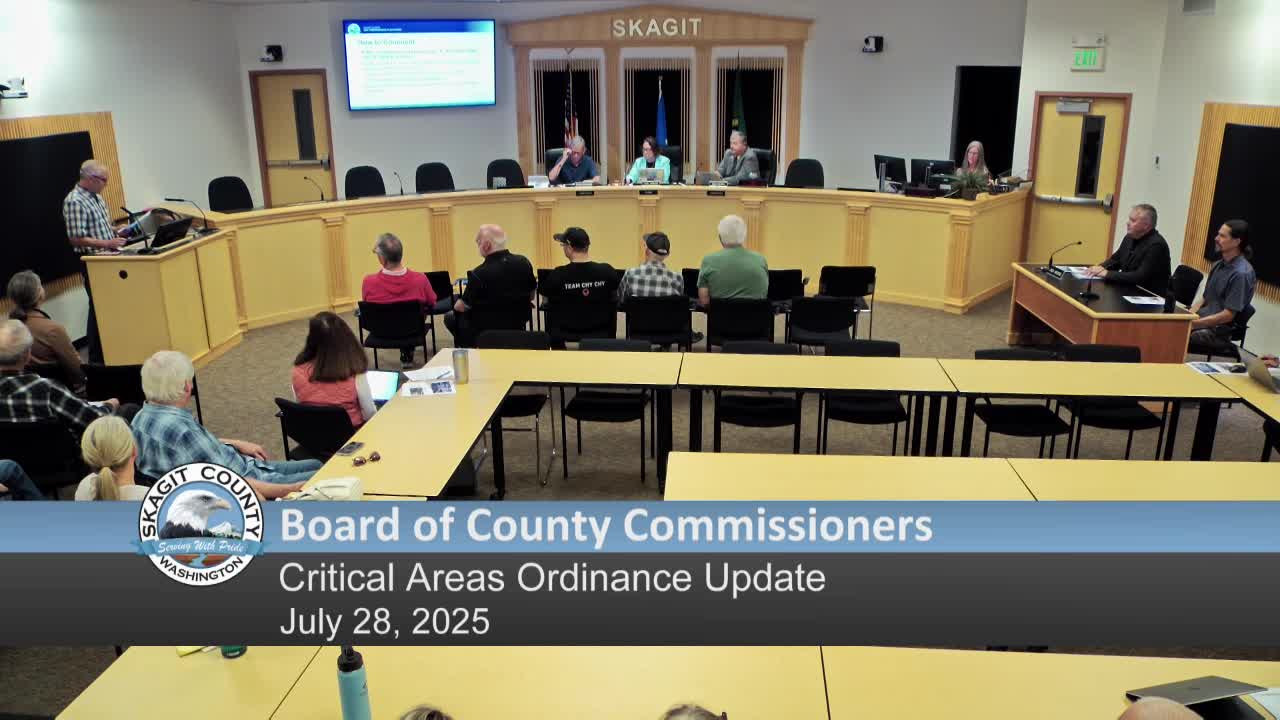Skagit County Considers Controversial Changes to Critical Areas Ordinance
July 28, 2025 | Skagit County, Washington
This article was created by AI summarizing key points discussed. AI makes mistakes, so for full details and context, please refer to the video of the full meeting. Please report any errors so we can fix them. Report an error »

In the heart of Skagit County, a gathering of local leaders and community members unfolded under the bright lights of the county hall, where the future of critical areas and agricultural practices took center stage. The meeting, held on July 28, 2025, was marked by passionate discussions surrounding the proposed updates to the county's Critical Areas Ordinance, a framework designed to protect vital ecosystems while balancing the needs of agriculture.
As the session progressed, voices from various organizations echoed the importance of maintaining ecological integrity without imposing undue burdens on farmers. Curt, a representative from a conservation group, emphasized that any mitigation efforts should not replace the fundamental need to protect critical areas. He urged the county to reconsider requirements that would mandate notifications for routine enhancement activities, such as planting native species or removing invasive plants, arguing that these measures could hinder essential conservation work.
Randy Goode, president of Friends of Skagit County, shared a historical perspective, recalling the collaborative efforts of farmers and landowners in the early 2000s to safeguard agricultural interests while adhering to environmental standards. He criticized the reliance on theoretical models for assessing water quality, advocating instead for field-tested science that reflects the realities of local conditions. Goode's remarks highlighted a growing frustration among agricultural stakeholders regarding the perceived disconnect between regulatory measures and practical farming needs.
Rick Haley, representing the Skagit Fisheries Enhancement Group, echoed similar sentiments, calling for the removal of unnecessary notification requirements for minor restoration activities. He argued that such regulations could stifle the day-to-day efforts of organizations dedicated to habitat restoration, diverting attention from more significant environmental concerns.
Laura Claus, from Skagitonians to Preserve Farmland, raised alarms about proposed expansions of riparian buffer widths, which could significantly impact agricultural land adjacent to waterways. She urged the county to consider the complexities farmers face and to avoid policies that might jeopardize the viability of agriculture in the region.
As the meeting drew to a close, the call for a Climate and Environment Advisory Board emerged, aiming to foster collaboration between various stakeholders in addressing the interconnected challenges of biodiversity, climate change, and sustainable agriculture. This proposal, while not part of the current ordinance, reflects a growing recognition of the need for a holistic approach to environmental stewardship in Skagit County.
The discussions at this meeting encapsulated the delicate balance Skagit County must navigate—protecting its rich ecosystems while ensuring that agriculture, a cornerstone of the local economy, continues to thrive. As community members left the hall, the air was thick with anticipation for how these deliberations would shape the future of both the land and its stewards.
As the session progressed, voices from various organizations echoed the importance of maintaining ecological integrity without imposing undue burdens on farmers. Curt, a representative from a conservation group, emphasized that any mitigation efforts should not replace the fundamental need to protect critical areas. He urged the county to reconsider requirements that would mandate notifications for routine enhancement activities, such as planting native species or removing invasive plants, arguing that these measures could hinder essential conservation work.
Randy Goode, president of Friends of Skagit County, shared a historical perspective, recalling the collaborative efforts of farmers and landowners in the early 2000s to safeguard agricultural interests while adhering to environmental standards. He criticized the reliance on theoretical models for assessing water quality, advocating instead for field-tested science that reflects the realities of local conditions. Goode's remarks highlighted a growing frustration among agricultural stakeholders regarding the perceived disconnect between regulatory measures and practical farming needs.
Rick Haley, representing the Skagit Fisheries Enhancement Group, echoed similar sentiments, calling for the removal of unnecessary notification requirements for minor restoration activities. He argued that such regulations could stifle the day-to-day efforts of organizations dedicated to habitat restoration, diverting attention from more significant environmental concerns.
Laura Claus, from Skagitonians to Preserve Farmland, raised alarms about proposed expansions of riparian buffer widths, which could significantly impact agricultural land adjacent to waterways. She urged the county to consider the complexities farmers face and to avoid policies that might jeopardize the viability of agriculture in the region.
As the meeting drew to a close, the call for a Climate and Environment Advisory Board emerged, aiming to foster collaboration between various stakeholders in addressing the interconnected challenges of biodiversity, climate change, and sustainable agriculture. This proposal, while not part of the current ordinance, reflects a growing recognition of the need for a holistic approach to environmental stewardship in Skagit County.
The discussions at this meeting encapsulated the delicate balance Skagit County must navigate—protecting its rich ecosystems while ensuring that agriculture, a cornerstone of the local economy, continues to thrive. As community members left the hall, the air was thick with anticipation for how these deliberations would shape the future of both the land and its stewards.
View full meeting
This article is based on a recent meeting—watch the full video and explore the complete transcript for deeper insights into the discussion.
View full meeting
